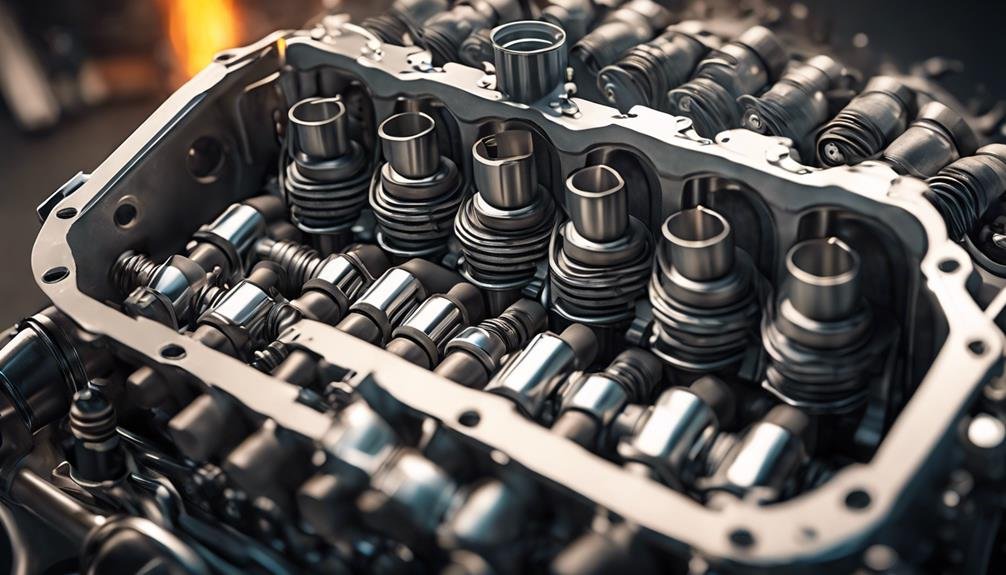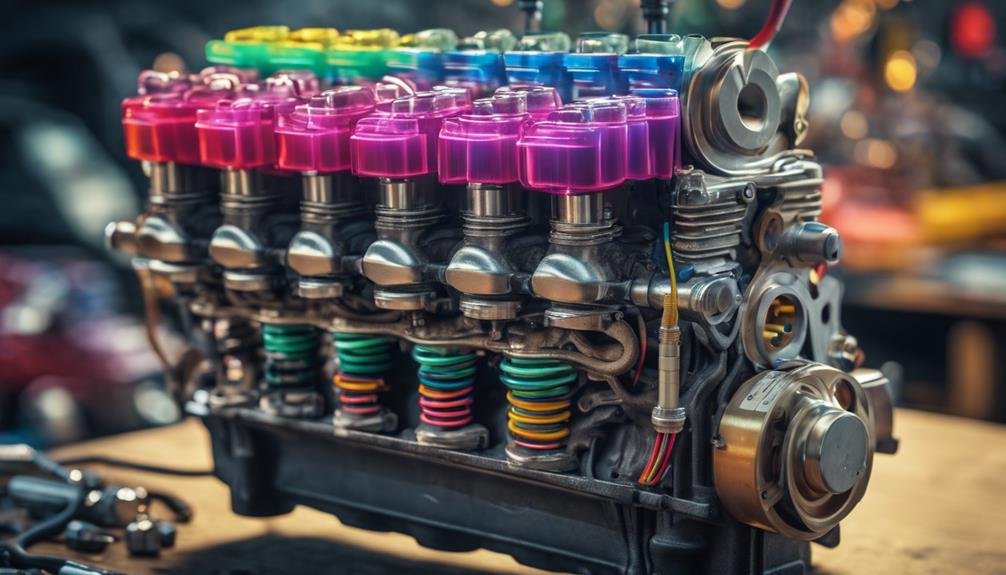As you investigate the intricacies of engine mechanics, understanding firing orders is vital for optimizing power delivery and guaranteeing reliability. The meticulously designed sequence of spark plug ignitions has a significant impact on your engine's performance. Different engine types have unique firing orders, and cylinder numbering systems vary across engine types. By delving into firing orders, you'll appreciate how it influences power delivery, engine balance, and overall performance. By continuing to delve into this topic, you'll uncover more about how firing orders are carefully designed to guarantee efficient combustion, reduce vibrations, and enhance power output.
Key Takeaways
- Firing order is crucial for engine performance, reliability, and power delivery, as it determines the sequence of spark plug ignition in an engine.
- Different engine types, such as straight, V, and radial engines, have unique firing orders optimized for their specific design and performance characteristics.
- A well-designed firing order ensures even power distribution, reduces vibrations, and improves engine efficiency, making it a critical aspect of engine tuning and optimization.
- Firing order diagnosis is vital for efficient engine performance and reliability, requiring specialized tools and knowledge to identify and rectify firing order issues.
- Understanding firing orders is essential for appreciating engine mechanics, as it influences engine noise, vibrations, and overall performance, and is critical for engine reliability and performance.
Understanding Firing Orders
When you investigate the inner workings of an engine, understanding the firing order is vital, as it dictates the sequence in which cylinders ignite to guarantee efficient combustion.
The specific firing order of an engine is key, as it directly impacts power delivery and engine performance. A well-designed firing order ensures that power is distributed evenly, resulting in a smoother engine operation. On the other hand, uneven firing can lead to vibrations, reduced power output, and potentially, engine damage.
Each engine type has a unique firing order, carefully crafted by the manufacturer to optimize engine design and performance. By understanding the firing order, you can appreciate the intricate balance of forces at play within the engine. This knowledge is crucial for maintaining engine reliability, performance, and ideal power delivery.
As you immerse yourself further into the world of engines, recognizing the significance of firing order will become second nature, allowing you to better appreciate the intricate mechanics that drive your vehicle forward.
Cylinder Numbering Systems
You'll find that cylinder numbering systems vary across engine types, with each design consideration influencing the unique numbering approach.
For instance, straight engines typically have cylinders numbered from the front to the rear for easy identification. However, V engines usually start cylinder numbering with the frontmost cylinder as #1, but numbering systems can vary among manufacturers.
Radial engines, on the other hand, have cylinders numbered clockwise around the circle for clear reference. Different engine types, like flat engines, may use unique cylinder numbering systems based on design considerations.
Moreover, cylinder numbering in vehicles can vary based on engine orientation, with rear-engine cars positioning cylinder #1 towards the firewall. Understanding these variations is important for determining firing orders, which rely on the specific cylinder numbering system.
A well-balanced engine configuration, spark ignition, and firing orders all rely on a clear understanding of cylinder numbering systems. By grasping these concepts, you'll better comprehend how engine balance and firing orders work together to ensure efficient engine performance.
Common Firing Orders Explained

With a solid grasp of cylinder numbering systems, you're now ready to investigate the different firing orders that engines use to achieve peak performance.
A firing order refers to the sequence in which spark plugs ignite fuel in an internal combustion engine's cylinders. This sequence greatly impacts an engine's power, smoothness, and general performance.
In a straight-four engine, common firing orders include 1-3-4-2 or 1-2-4-3, which enable ideal power delivery.
Flat-four engines, on the other hand, typically follow the sequence R1-R2-L1-L2 to ensure balanced power delivery.
Meanwhile, straight-five engines often employ the firing order 1-2-4-5-3 to minimize vibrations and improve engine smoothness.
In V8 engines, the firing order can vary based on manufacturer and design, impacting power delivery and engine balance.
Understanding these common firing orders is important for maximizing an engine's potential and achieving peak performance.
Firing Interval and Timing
As you delve deeper into the intricacies of engine performance, understanding the firing interval and timing becomes vital, as it directly impacts combustion efficiency and general engine operation.
The firing interval, typically 180 degrees, is the duration between ignition events in a four-stroke engine, which is half the crankshaft rotation. Proper firing timing is critical for peak power delivery and engine efficiency, as it guarantees that each cylinder ignites at the correct moment.
Even firing intervals are important, as they help distribute torque evenly and reduce vibrations, resulting in a smoother engine operation.
The firing order determines the sequence in which cylinders ignite during each engine cycle, and proper timing between ignition events ensures that each cylinder fires in the correct sequence.
Engine Configuration and Design

When designing an engine, manufacturers carefully consider the firing order to optimize power delivery, minimize vibrations, and guarantee smooth operation. It's the engine's configuration and design that ultimately dictate the feasibility of a particular firing order.
As you investigate the intricacies of engine design, you'll find that firing orders vary greatly depending on the number of cylinders and manufacturer specifications. The engine configuration, comprising cylinder banks, spark plug wires, and other components, plays a critical role in determining the ignition sequence.
A well-designed firing order ensures balance, harmony, and efficient combustion, which in turn impacts the overall performance, reliability, and maintenance of the engine.
In an inline engine, for instance, the firing order is often sequential, whereas in a V-type engine, the firing order is typically staggered to minimize vibrations.
Ignition Components Overview
You'll find that ignition components like distributors, coils, and spark plug wires play a vital role in delivering the high voltage spark needed to ignite the fuel-air mixture in your engine. These components work together to generate the spark that ignites the fuel-air mixture in each cylinder, following a specific firing order.
Understanding how these components interact is important for peak engine performance. In a typical engine, the distributor cap and rotor distribute the spark to each cylinder, while the spark plug wires transmit the high voltage spark to the spark plugs. Choosing the correct distributor gear is necessary to prevent premature wear on the camshaft gear, as misalignment can lead to premature wear and tear.
Multi-Cylinder Engine Firing Orders

In multi-cylinder engines, the firing order determines how the spark plugs ignite the fuel-air mixture in each cylinder. Getting it right is essential for balancing forces, optimizing power delivery, and maintaining engine reliability.
Concerning 4-cylinder engines, common firing orders include 1-3-4-2, 1-2-4-3, or 1-4-3-2, each impacting power delivery and engine balance.
Straight-five engines typically follow the firing order 1-2-4-5-3 to minimize vibrations and ensure smooth operation.
For 6-cylinder engines, different firing orders like 1-5-3-6-2-4 can influence engine performance and harmonics.
Even 3-cylinder engines have their own firing orders, such as 1-2-3 or 1-3-2, affecting combustion timing and engine efficiency.
By optimizing firing orders, engines can achieve better engine balance, reducing vibrations and noise.
Understanding firing orders is vital for maximizing engine performance. Getting it wrong can lead to poor engine balance, decreased power, and even engine damage.
Firing Order Tuning and Optimization
By adjusting the firing order, you can reveal your engine's complete potential, reaching peak power delivery and a smoother ride. Firing order tuning involves fine-tuning the ignition sequence for best power delivery, which can greatly improve engine performance.
By optimizing the firing order, you can reduce vibrations, improve exhaust scavenging, and optimize power output. This, in turn, minimizes stress on engine components, leading to improved durability and efficiency.
Engine optimization through firing order tuning is essential for achieving peak performance, as it allows for a more efficient combustion process.
By adjusting the firing order, you can tailor the ignition sequence to your engine's specific needs, resulting in improved power delivery, reduced vibrations, and improved overall engine response.
With proper firing order optimization, you can reveal your engine's full potential, achieving a smoother, more efficient ride.
Engine Performance and Reliability

Proper firing order is vital for achieving peak engine performance and reliability, as it guarantees precise timing for efficient combustion, preventing misfiring and engine damage while maximizing power output.
When you explore the world of engine performance, it's important to understand the significance of firing order in optimizing your engine's potential.
Here are some key takeaways to keep in mind:
- A well-designed firing order helps reduce vibrations, ensuring a smoother ride and quieter operation.
- Evenly spaced firing intervals distribute torsional forces evenly across the crankshaft, reducing mechanical stress and wear.
- Correct firing order prevents misfiring, engine damage, and ensures maximum power output, resulting in better fuel efficiency and overall performance.
- Firing order affects engine noise and vibrations, influencing overall performance and smooth operation.
- Specific firing orders are designed to minimize vibrations, optimize power delivery, and improve engine performance, making it a critical aspect of engine tuning and optimization.
Tools for Firing Order Diagnosis
When diagnosing firing order issues, you'll need a range of specialized tools to identify the problem and get your engine running smoothly again. Diagnostic tools like timing lights and scan tools are vital for determining firing order issues in engines.
A visual inspection of spark plug wires and the distributor cap can also reveal misfiring cylinders, helping you pinpoint the problem. To make sure correct wire routing, use a cylinder order diagram specific to your engine.
Multimeters are also useful for testing spark plug wires for continuity, identifying faulty connections that may be causing ignition problems. Moreover, firing order diagnostic charts and manuals provide detailed information for troubleshooting ignition problems.
By using these tools in conjunction with your knowledge of firing orders, you'll be well-equipped to diagnose and fix ignition problems. Remember, understanding firing orders is important for efficient engine performance and reliability.
With the right tools and knowledge, you'll be able to identify and rectify firing order issues, getting your engine running smoothly and efficiently.
Frequently Asked Questions
What Does Firing Order 1-3-4-2 Mean?
When you see 'firing order 1-3-4-2', it means the sequence of ignition in your engine's cylinders. You'll know that cylinder 1 fires at the beginning, then 3, 4, and ultimately 2, ensuring your engine runs smoothly and efficiently.
How Does an Engine Firing Order Work?
You're wondering how an engine firing order works? It's like a choreographed dance: the spark plugs ignite fuel in a specific sequence, ensuring each cylinder fires at the right time to power your ride smoothly and efficiently.
How to Calculate Firing Order of Engine?
You'll need to identify the cylinder numbering system and sequence of firing to calculate the firing order; refer to the engine's manual or technical documentation to get the correct information, ensuring proper ignition timing.
What Engine Has the Firing Order 1 8 4 3 6 5 7 2?
You're wondering what engine has the firing order 1 8 4 3 6 5 7 2? Well, you're likely to find this sequence in V8 engines, particularly in the Chevrolet Small Block V8.
Conclusion
By now, you've gained a thorough understanding of firing orders in engines, including cylinder numbering systems, common firing orders, and the importance of firing interval and timing.
You've also learned how engine configuration and design impact firing orders, and how to optimize them for better performance and reliability.
With this knowledge, you're equipped to diagnose and fine-tune firing orders, ultimately improving your vehicle's overall performance and longevity.
